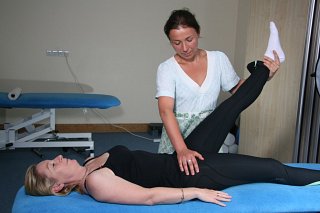Exercise for Sciatica
Sciatic Stretches
Read this article before you exercise!

Over the years since I started this website, I have had a few people contact me looking for exercises for sciatica. However, I am reluctant to offer general sciatic exercises without seeing the patient, as the type of exercise you should do will depend very much on the cause of your sciatica.
To illustrate why exercises have to be specific to your sciatica symptoms, let me give you the following example:
I have seen other websites and youtube channels offer examples of sciatic stretches, where they encourage you to perform exercises in a flexion/forward direction, with little or no consideration as to the cause of the sciatic pain. But what if your sciatic nerve is being squeezed or irritated by a disc bulging backwards (say a posterior bulge in the L5/S1 vertebrae) - then if you were to do those exercises you are at risk of further pushing the disc out and compromising your sciatic nerve even more, even leading to a disc herniation if you were unlucky. So be warned!
In such a situation your physiotherapist physical therapist will need to advise you on a range of exercises to support an extension/arching backwards direction - these will encourage your prolapsing disc to correct itself. It is vital to take into consideration the direction of any dysfunction in the overall management of your sciatica.
The important thing to be aware of is that if you do the wrong type of exercise for your sciatica, it could cause temporary irritation to the sciatic nerve, and if unlucky more permanent irritation. You need to consider this before you read and follow articles on the internet offering ‘stretches for sciatica’ or ‘sciatic exercises’.
Sponsored links
Sciatic Exercises - two high level tips.
Once you have identified the underlying cause of your sciatica, then you will find, with the aid of a chartered physiotherapist or physical therapist.
However, so seeing as many of you have come to this webpage looking for exercises that will help relieve sciatica, well there are two bits of high level advice I can give:
-
Firstly, avoid repetitive positions or postures for any length of time and move all parts of your body that do not hurt on a regular basis. Don’t let your sciatica discomfort cause all of your body to shut down! Lack of movement in any injury can lead to secondary problems - you keep moving in a pain free fashion as much as you.
-
Secondly, working on reaching and maintaining a good posture will help both in the early and long term stages of sciatic pain relieve.
What I mean by this is that when we have sciatica, we have a tendency, slump which - although may give us initial comfort - usually will affect your sciatic nerve negatively. Become aware of your posture and try to maintain a good posture. To immediately improve your standing posture, imagine a hot air balloon coming from the top of your head and lengthening you towards the ceiling.
For an improved sitting posture, sit on a supportive chair and again lengthen the top of your head towards the ceiling - this will result in your sit bones being lifted in the same direction.
You can also use back pain relief products like “back friends” and lumbar rolls to facilitate this.
In Conclusion
In conclusion, the key to an appropriate type and level of sciatic exercises will depend on the diagnosis and direction of cause of your sciatica. Once the correct movement dysfunction has been discovered, then the appropriate exercises will be advised. If you are looking for exercises for sciatic pain relief, it is best to seek advice from a medically trained professional such as a trained Physiotherapist.
Together you will discover the underlying cause of the irritation of the sciatic nerve and work toward resolving that, normally through manual therapy and exercises specific to the problem. Simply following exercise over the internet will not always be effective and if unlucky could make the problem worse.
If you liked this article and think it would be helpful to share with others, please feel free to do so. You can share it by clicking on one of the social media buttons below.
DISCLAIMER
While the content and materials contained in the articles on this website have been written & researched by Sally Ann Quirke, a professional, practising & fully qualified Chartered Physiotherapist (Physical Therapist) based in Ireland, they are provided for general information and educational purposes only. They do not constitute medical advice on any particular individual situation. Please see your Chartered Physiotherapist or other medical practitioner for full and individual consultation.
Please read the full disclaimer here.
Cookies and Privacy
By using this website, you consent to the use of cookies in accordance with our cookie policy. For more information on how we use cookies, please read our cookie policy here.
